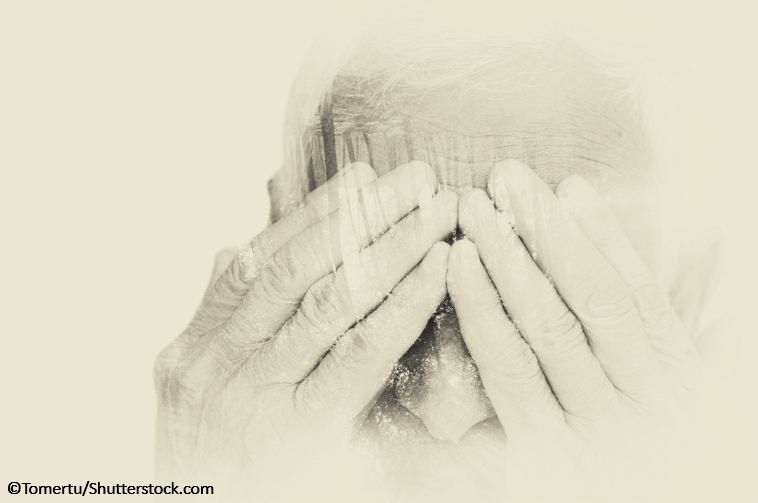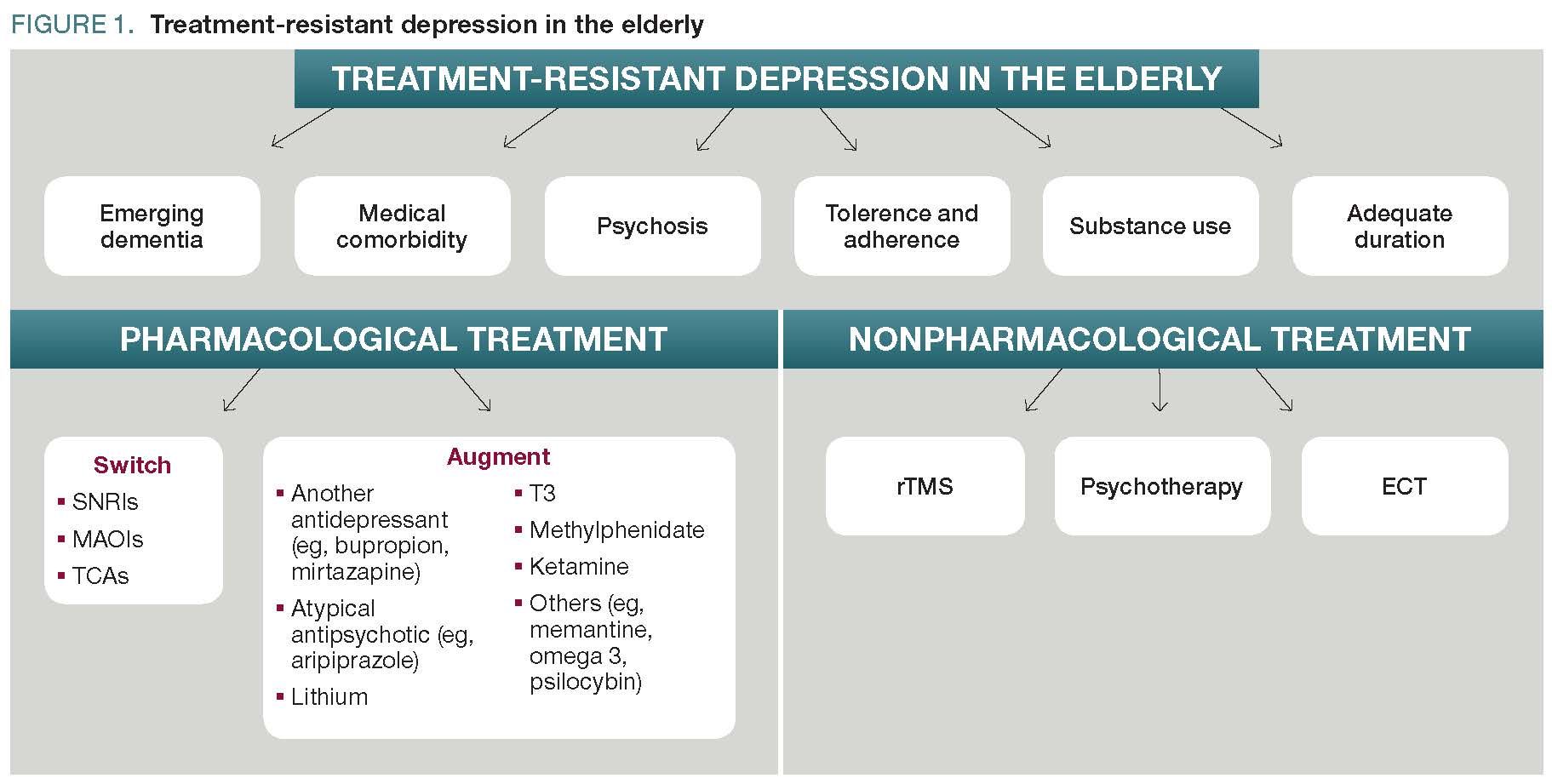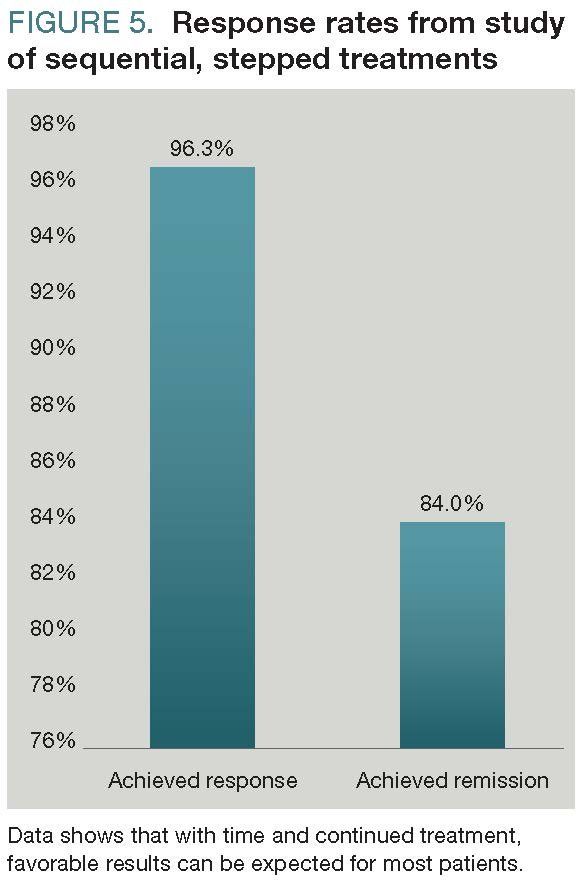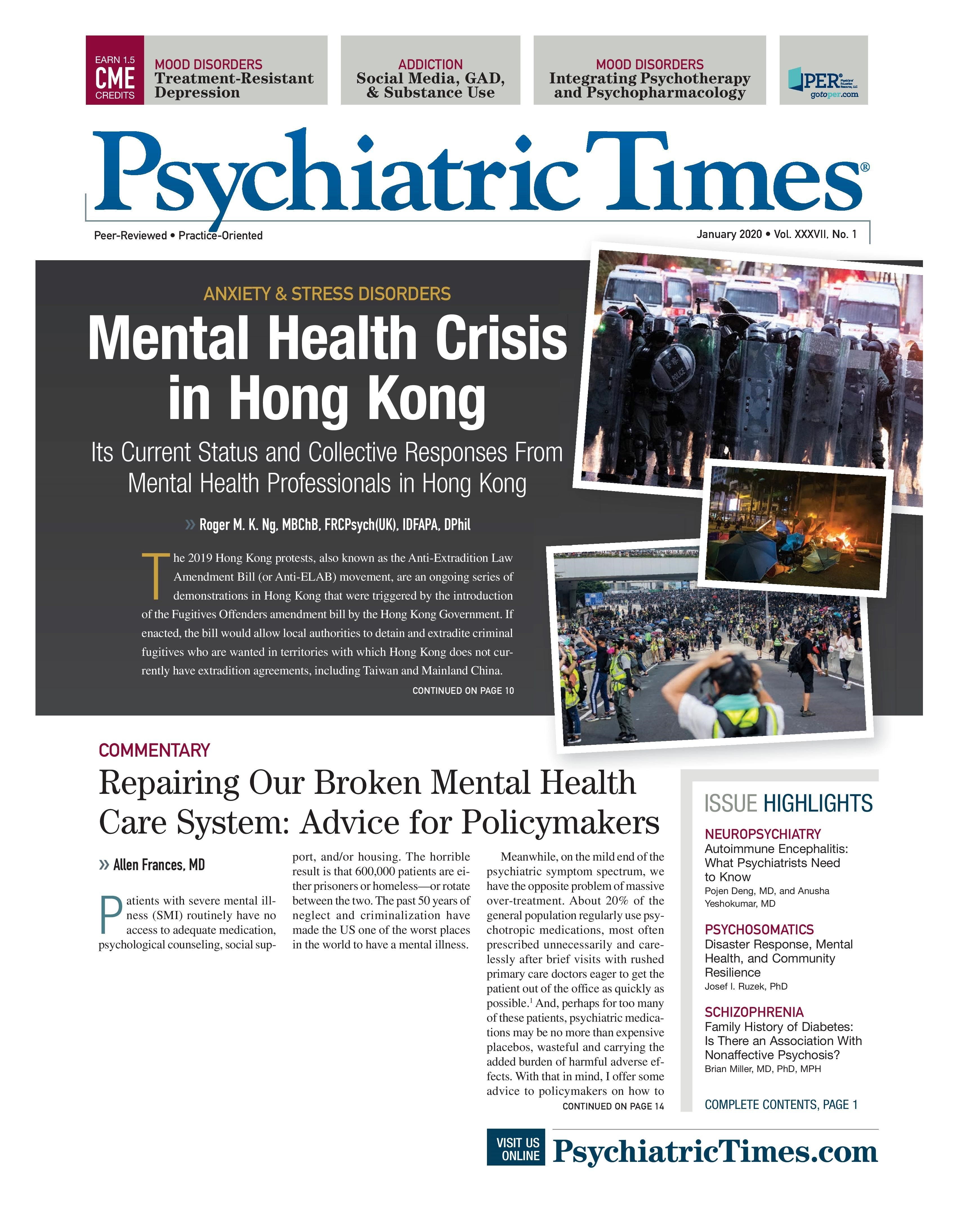Publication
Article
Psychiatric Times
Management of Treatment Resistant Depression in the Elderly
Author(s):
This CME activity provides an understanding of treatment resistant depression (TRD) in elderly patients.
© Tomertu/Shutterstock

FIGURE 1. Treatment-resistant depression in the elderly

FIGURE 2. Vascular depression

FIGURE 3. Symptomology in geriatric depression

FIGURE 4. Medical comorbidities

FIGURE 5. Response rates from study of sequential, stepped treatments

FIGURE 6. Psychotherapeutic options

Clinical Assessment and Treatment Strategies
Premiere Date: January 20, 2020
Expiration Date: July 20, 2021
This activity offers CE credits for:
1. Physicians (CME)
2. Other
All other clinicians either will receive a CME Attendance Certificate or may choose any of the types of CE credit being offered.
ACTIVITY GOAL
The goal of this activity is to provide an understanding of treatment resistant depression (TRD) in elderly patients.
LEARNING OBJECTIVES
After engaging with the content of this CME activity, you should be better prepared to:
• Differentiate the presentation of TRD in older patients
• Describe medical comorbidities in older patients with TRD
• Explain treatment strategies for elderly patients with TRD: switching versus augmentation
• Describe FDA approved pharmacological agents for treating depression and TRD
TARGET AUDIENCE
This continuing medical education (CME) activity is intended for psychiatrists, psychologists, primary care physicians, physician assistants, nurse practitioners, and other health care professionals who seek to improve their care for patients with mental health disorders.
ACCREDITATION/CREDIT DESIGNATION/FINANCIAL SUPPORT
This activity has been planned and implemented in accordance with the accreditation requirements and policies of the Accreditation Council for Continuing Medical Education (ACCME) through the joint providership Physicians’ Education Resource®, LLC and Psychiatric Times. Physicians’ Education Resource®, LLC is accredited by the ACCME to provide continuing medical education for physicians.
Physicians’ Education Resource®, LLC designates this enduring material for a maximum of 1.5 AMA PRA Category 1 Credits™. Physicians should claim only the credit commensurate with the extent of their participation in the activity.
This activity is funded entirely by Physicians’ Education Resource®, LLC. No commercial support was received.
OFF-LABEL DISCLOSURE/DISCLAIMER
This CME activity may or may not discuss investigational, unapproved, or off-label use of drugs. Participants are advised to consult prescribing information for any products discussed. The information provided in this CME activity is for continuing medical education purposes only and is not meant to substitute for the independent clinical judgment of a physician relative to diagnostic or treatment options for a specific patient’s medical condition.
The opinions expressed in the content are solely those of the individual faculty members and do not reflect those of Physicians’ Education Resource®, LLC.
FACULTY, STAFF, AND PLANNERS’ DISCLOSURES
Fred Liu, MD; Awais Aftab, MD; and the staff of Physicians’ Education Resource®, LLC and Psychiatric Times have no relevant financial relationships with commercial interests.
Jonathan Alpert, MD (peer, content reviewer): grants received from the Patient-Centered Outcomes Research Institute; research support from Otsuka Pharmaceuticals and Axsome Therapeutics.
For content-related questions, please email us at PTeditor@mmhgroup.com; for questions concerning the accreditation of this CME activity or how to claim credit, please contact info@gotoper.com and include “Management of Treatment Resistant Depression in the Elderly: Clinical Assessment and Treatment Strategies” in the subject line.
HOW TO CLAIM CREDIT
Once you have read the article, please use the following URL to evaluate and request credit: https://education.gotoper.com/activity/ptcme20jan.
If you do not already have an account with PER,® you will be prompted to create one. You must have an account to evaluate and request credit for this activity.
Among adults aged more than 55 years, the prevalence of major depressive disorder is about 2% globally overall with up to 10% to 20% of all older adults suffering from a clinically significant depressive syndrome; the prevalence is higher among patients in hospitals and nursing homes who are older than 85.1 Untreated depression can lead to a variety of negative outcomes such as functional impairment, increased risk of a neurocognitive disorder, increased morbidity and mortality, increased use of illicit substances and alcohol, more hospitalizations, and higher rates of suicide. Moreover, many depressed elderly patients will not respond to first-line pharmacological therapy and will need a switch to another agent or will need to have treatment augmentation (Figure 1).
Defining depression
Despite the high incidence of treatment-resistant depression (TRD), there is no universally agreed upon definition for it; a common definition is “an inadequate response to at least two antidepressant trials of adequate dose and duration.” Another construct is treatment refractory depression (TRefD), which is sometimes used synonymously with TRD and sometimes refers only to highly resistant forms of depression that have not responded to numerous interventions.
A categorical definition of treatment resistance may be devoid of validity. This has resulted in a focus on staging and levels of resistance, as well as an alternative notion of “difficult to treat” depression, which may fit better with the recurrent and chronic nature of the illness.
Furthermore, aside from specific cases such as vascular depression where MRI can detect subcortical white matter hyperintensities (Figure 2), there remains no validated biological marker for depression in clinical use for the diagnosis and treatment of TRD. Rating scales such as the Geriatric Depression Scale (GDS), the Patient Health Questionnaire (PHQ-9), and the Hamilton Depression Rating Scale (HRSD) can be clinically helpful in identifying and monitoring treatment progress.
Special concerns in the elderly
An important consideration in assessment of late-life depression is to distinguish late-onset depression, in which depressive disorder is experienced for the first time in later life, from early-onset depression, in which depression symptoms are the continuation of a depressive illness that started earlier in life. This distinction is clinically important because late-onset depression frequently develops in the context of medical morbidity, such as heart disease/stroke (vascular etiology), dementia (neurodegenerative illness), or multimorbidity and chronic inflammation.
Vascular depression is a subtype of late-life depression, especially late-onset, characterized by a distinct clinical presentation and an association with cerebrovascular damage, with MRI findings of extensive white matter hyperintensities, subcortical microvascular lesions, lacunes, and microinfarcts.
Depression in elderly patients may not present with a straightforward textbook presentation (Figure 3). There can be a myriad of atypical symptoms such as memory problems, physical symptoms (eg, fatigue, weight loss, pain), and behavioral symptoms (eg, social withdrawal, difficulty with self-care, refusal to eat or drink).
Major neurocognitive disorder (MNCD) in its early stages can present predominantly with depressive symptoms. There is a 10% to 30% prevalence of depressive symptoms in elderly patients with Alzheimer disease.2 Even with appropriate treatment, patients with MNCD may be mistakenly labeled as having TRD because of ongoing psychomotor retardation, sleep problems, and cognitive impairments. Thus, a low threshold for suspecting an underlying MNCD is recommended in depressed elderly patients.
General medical illness also can contribute to affective disorders in elderly patients. Treating the medical illness is an integral part in treating depression in these patients (Figure 4).
Examples of medical comorbidities recognized as being associated with a higher risk of depression include endocrinologic disorders such as hypothyroidism and Cushing syndrome as well as neurological disorders (eg, stroke, heart disease, arthritis, pancreatic carcinoma and other cancers, connective tissue disorders, vitamin deficiencies, and viral infections).
Vitamin B12 and folate deficiency may increase the risk of depression; moreover, this deficiency has been linked to poor antidepressant responses.3 Nevertheless, vitamin deficiencies are often underappreciated, and there are no clear clinical guidelines regarding screening for vitamin deficiencies in MDD. Medications such as steroids, sedatives, and immunosuppressants may play a role in depression and must also be considered in the elderly patient.
Elderly patients with depression are more likely to have psychotic symptoms that may be severe enough to require hospitalization. In these cases, treatment involves the use of antipsychotics in addition to antidepressants. However, in milder cases, symptom remission may occur with antidepressants alone. Flint and colleagues4 examined maintenance treatment for psychotic depression (mean age=55). Their findings indicate long-term treatment with olanzapine and sertraline was more effective for relapse prevention than sertraline or placebo.
The prevalence of substance and alcohol misuse in the elderly is surprisingly high and should not be overlooked. Depressive symptoms are unlikely to respond to treatment in the presence of an active substance or alcohol use disorder.
Treatment considerations
The inability to tolerate an antidepressant due to adverse effects that leads to nonadherence may be mistaken clinically as treatment-resistance. Nonadherence and difficulty tolerating medications can lead to worse treatment outcomes in the depressed elderly patient.
The choice of initial antidepressant therapy has a bearing on treatment tolerance and adherence. Tricyclic antidepressants (TCAs) are strong anticholinergic agents. Paroxetine should be carefully utilized because of its anticholinergic effects and medication interactions via inhibition of the cytochrome P450 system. Caution is also warranted with fluoxetine because of its long half-life, active metabolites and its inhibition of the cytochrome P450 system.
The typical duration for an adequate trial of antidepressant is typically 6 to 8 weeks in adults. However, elderly patients may require a longer duration of treatment to achieve adequate response, upwards of 8, 10, or 12 weeks. Treatment response may be slower in some elderly, thus they will need longer antidepressant trials.
After appropriate diagnosis and assessment of special considerations in the elderly patient, treatment decisions need to be made. Interventions can be pharmacological, nonpharmacological, or a combination of both.
Psychopharmacology
There is some evidence that in geriatric TRD, switching from a selective serotonin reuptake inhibitors to venlafaxine or duloxetine (serotonin–norepinephrine reuptake inhibitor) may lead to response or remission.5,6 Clinical experience also supports the use of bupropion, mirtazapine, and other atypical antidepressants such as vortioxetine and vilazodone, although evidence specific to late-life TRD is lacking.
Selegiline has also shown efficacy in a study of older adults with TRD, and it was well tolerated at high doses (eg, 60 mg/d). In another study that included older patients, monoamine oxidase inhibitors (MAOIs) were shown to be more effective than tricyclic antidepressants (TCAs) in early stage TRD.7
There are several FDA-approved antipsychotics that can be used as augmentation therapy for patients with TRD or inadequate response to first-line antidepressants. FDA-approved antipsychotics include olanzapine (in conjunction with fluoxetine), quetiapine, aripiprazole, and brexpiprazole. Other atypical antipsychotics such as risperidone and ziprasidone also have some evidence of efficacy but are not FDA approved. Among the atypical antipsychotics, aripiprazole augmentation has perhaps the best evidence for use in the elderly population and has the most data that supports its efficacy and safety. Lenze and colleagues8 undertook a study of aripiprazole augmentation in adults aged 60 years or older who had not achieved remission from depression with a first-line antidepressant: 44% experienced remission with aripiprazole augmentation compared to 29% with placebo.
Lithium augmentation is an effective but underutilized strategy for TRD in elderly patients. An open, randomized controlled trial compared lithium augmentation to phenelzine in 29 elderly inpatients with TRD.9 Symptom remission, measured by a MADRS score of less than or equal to 10, was seen in 33.3% of the patients who received lithium; no symptoms remission seen in the patients who received phenelzine.
Findings from a recent study showed a response rate of 68% in elderly patients (improvement in depressive symptoms by at least 50%) treated with lithium augmentation.10 It is interesting to note that elderly patients were twice as likely to achieving a response compared with younger patients.
The use of triiodothyronine (T3) is an evidence-based augmentation strategy for depression, which has been shown to be beneficial in multiple randomized clinical trials. In the STAR*D study, which included elderly patients with TRD, T3 augmentation up to 50 mcg daily led to remission rates of 24.7% compared with 15.9% with lithium augmentation. Moreover, T3 was better tolerated than lithium.11
Although not beneficial on its own, augmentation with methylphenidate has some evidence to support its use in the treatment of depression in elderly patients. In a 16-week randomized double-blind placebo-controlled trial on geriatric depression in 143 outpatients, methylphenidate (5-40 mg) augmentation to citalopram (20-60 mg) had greater efficacy in treating depression than either citalopram or methylphenidate alone.12
In research studies, intravenous ketamine shows a rapid reduction in depressive symptoms with effects peaking at 24 hours, and usually lasting up to a week.13 The FDA recently approved the use of intranasal esketamine (S+ enantiomer of ketamine) for adults with TRD when used in conjunction with an oral antidepressant.
A 4-week, randomized, double-blind study conducted specifically in elderly patients with TRD compared flexibly-dosed intranasal esketamine plus a newly initiated oral antidepressant with placebo and an antidepressant.14 The results showed no statistically significant difference between the two groups on the primary efficacy endpoint at week 4. However, in a subgroup analysis restricted to US patients, significant improvement in MADRS total scores was seen with intranasal esketamine. More research is needed to determine the relative efficacy and safety of various formulations of ketamine in the elderly population.
There are indications that memantine has no effect on depression.15,16 On the other hand, omega-3 fatty acids may have some benefit for elderly patients with mild to moderate depression.17 Other possible treatments for TRD include the use of antimuscarinic agents (such as scopolamine), anti-inflammatory agents, and psychedelics such as psilocybin, but more research is needed for their use in general as well as in the elderly patient. L-methylfolate has also emerged as a promising treatment for SSRI-resistant major depression in adults, but remains to be studied specifically in late-life TRD.
In a 3-year study of late-life patients with TRD, 81 patients were treated sequentially with a variety of different interventions, such as venlafaxine/nortriptyline, lithium, monamine oxidase inhibitor, TCA, and ECT. At the end of this sequential study, 78 of the 81 patients (96.3%) had achieved response and 68 patients (84%) achieved remission within the 3 years of observation. In the 68 patients who had symptom remission, the mean time to remission was 27.3 weeks. This study demonstrates the clinical utility of sequential, stepped treatments-with time and continued treatment favorable results can be expected for most patients (Figure 5).18
Nonpharmacological interventions
Overall, the research on the efficacy of psychotherapy for elderly patients with TRD is limited; however, it is reasonable and highly recommended to utilize this as part of the treatment plan for TRD (Figure 6). Various psychotherapy modalities such as problem-solving therapy, cognitive behavioral therapy (CBT), and interpersonal psychotherapy have been shown to be effective for late-life depression, especially CBT which is the best studied.19 Psychotherapeutic interventions have a large antidepressant effect size among older patients compared with control groups (Hedges g 0.64, 95% CI, 0.47-0.80; NNT of 3), which suggests many treatment-resistant depressed elderly patients may benefit from these interventions.20
Repetitive transcranial magnetic stimulation (rTMS) has been approved for the treatment of TRD in adults, although there are only a few studies specific to elderly patients. Some findings suggest response rates of up to 58.5% while others have shown either no benefit or diminishing treatment response with increasing age. A recent study showed a response rate of 40% in elderly patients with TRD with bilateral TMS compared with unilateral and sham treatments with good tolerability and few drop-outs.21
ECT is considered the most effective treatment for MDD and TRD with remission rates of 75% and 50%, respectively. In fact, the response rate in elderly patients may be even better than that in younger patients, although it may take longer for the elderly patient to respond to treatment. Findings suggest that 78% of elderly patients with TRD treated with ECT have at least a 50% reduction in symptoms; more than 60% of participants meet criteria for remission.22 Patients who benefit from ECT includ elderly patients with psychotic symptoms and TRD. It was noted that a higher number of psychotic symptoms was associated with better response.
Conclusion
TRD is often clinically defined as failure to respond to adequate trials of at least two antidepressants, although there is no universally accepted definition. In the elderly patient, initial assessment of TRD is complicated by various factors such as emerging neurocognitive disorder, comorbid medical conditions, psychotic symptoms, treatment tolerance as well as atypical presentations and the need for longer treatment durations. Treatment strategies for TRD include switching to medications of a different class (SNRIs, TCAs, MAOIs), use of augmentation agents (eg, lithium, atypical antipsychotics, thyroid hormone, ketamine/esketamine) and nonpharmacologic interventions such as ECT.
Geriatric TRD is an area of increasing research focus and studies are ongoing that may provide additional guidance to clinicians. One such study is the Optimizing Outcomes of Treatment-Resistant Depression in Older Adults (OPTIMUM) trial in which augmentation versus switching monotherapies for the treatment of TRD in the elderly patient are being studied.23
CME POST-TEST
Posttest, credit request forms, and activity evaluations must be completed online at https://education.gotoper.com/activity/ptcme20jan (requires free account activation), and participants can print their certificate or statement of credit immediately (80% pass rate required). This website supports all browsers. For PER’s privacy policy, please visit https://www.gotoper.com/privacy.
PLEASE NOTE THAT THE POSTTEST IS AVAILABLE ONLINE ONLY ON THE 20TH OF THE MONTH OF ACTIVITY ISSUE AND FOR 18 MONTHS AFTER.
Need Additional CME Credit? Check Out These Free CME Activities-
Physician Work-Associated Trauma: Causes, Consequences, and Interventions
Joshua A. Morganstein, MD
Expiration Date: February 20, 2020
Psychocardiology: Understanding the Heart-Brain Connection: Part 1
Angelos Halaris, MD
Expiration Date: March 20, 2020
Disclosures:
Dr Liu is a fourth-year Psychiatry Resident, University of California, San Diego, CA. Dr Aftab is an Attending Psychiatrist, Northcoast Behavioral Healthcare, Ohio Department of Mental Health and Addiction Services, Northfield, OH.
References:
1. Beekman AT, Copeland JR, Prince MJ. Review of community prevalence of depression in later life. Br J Psychiatry.1999;174:307-311.
2. Wragg RE, Jeste DV. Overview of depression and psychosis in Alzheimer disease. Am J Psychiatry. 1989;146:577-587.
3. Alpert JE, Fava M. Nutrition and depression: the role of folate. Nutrition Rev. 1997;55:145-149.
4. Flint AJ, Meyers BS, Rothschild AJ, et al. Effect of continuing olanzapine vs placebo on relapse among patients with psychotic depression in remission: the STOP-PD II randomized clinical trial. JAMA. 2019;322:622–631.
5. Mazeh D, Shahal B, Aviv A, et al. A randomized, single-blind, comparison of venlafaxine with paroxetine in elderly patients suffering from resistant depression. Int Clin Psychopharm. 2007;22:371-375.
6. Karp JF, Whyte EM, Lenze EJ, et al. Rescue pharmacotherapy with duloxetine for selective serotonin reuptake inhibitor nonresponders in late-life depression: outcome and tolerability. J Clin Psychiatry. 2008;69:457-463.
7. Kim T, Xu C, Amsterdam JD. Relative effectiveness of tricyclic antidepressant versus monoamine oxidase inhibitor monotherapy for treatment-resistant depression. J Affect Disord. 2019;250:199-203.
8. Lenze EJ, Mulsant BH, Blumberger DM, et al. Efficacy, safety, and tolerability of augmentation pharmacotherapy with aripiprazole for treatment-resistant depression in late life: a randomised, double-blind, placebo-controlled trial. Lancet. 2015;386:2404-2412.
9. Kok RM, Vink D, Heeren TJ, Nolen WA. Lithium augmentation compared with phenelzine in treatment-resistant depression in the elderly: an open, randomized, controlled trial. J Clin Psychiatry. 2007;68:1177-1185.
10. Buspavanich P, Behr J, Stamm T, et al. Treatment response of lithium augmentation in geriatric compared to non-geriatric patients with treatment-resistant depression. J Affect Disord. 2019;251:136-140.
11. Nierenberg AA, Fava M, Trivedi MH, et al. A comparison of lithium and T 3 augmentation following two failed medication treatments for depression: a STAR* D report. Am J Psychiatry. 2006;163:1519-1530.
12. Lavretsky H, Reinlieb M, St Cyr N, et al. Citalopram, methylphenidate, or their combination in geriatric depression: a randomized, double-blind, placebo-controlled trial. Am J Psychiatry. 2015;172:561-569.
13. Han Y, Chen J, Zou D, et al. Efficacy of ketamine in the rapid treatment of major depressive disorder: a meta-analysis of randomized, double-blind, placebo-controlled studies. Neuropsych Dis Treat. 2016;12:2859-2867.
14. Bahr R, Lopez A, Rey JA. Intranasal esketamine (Spravato™) for use in treatment-resistant depression in conjunction with an oral antidepressant. P&T. 2019;44:340-375.
15. Omranifard V, Shirzadi E, Samandari S, et al. Memantine add on to citalopram in elderly patients with depression:a double-blind placebo-controlled study. J Res Med Sci .2014;19:525-530.
16. Lenze EJ, Skidmore ER, Begley AE, et al. Memantine for late-life depression and apathy after a disabling medical event: a 12-week, double-blind placebo-controlled pilot study. Int J Geriatr Psychiatry. 2012;27:974-980.
17. Bae JH, Kim G. Systematic review and meta-analysis of omega-3-fatty acids in elderly patients with depression. Nutrit Res. 2018;50:1-9.
18. Nolan RM Heeren TJ. Outcome of late-life depression after 3 years of sequential treatment. Acta Psychiatrica Scand. 2009;119:274-281.
19. Huang AX, Delucchi K, Dunn LB, Nelson JC. A systematic review and meta-analysis of psychotherapy for late-life depression. Am J Geriatr Psychiatry. 2015;23:261-273.
20. Kok RM, Reynolds CF. Management of depression in older adults: a review. JAMA. 2017;317:2114-2122.
21. Trevizol AP, Goldberger KW, Mulsant BH, et al. Unilateral and bilateral repetitive transcranial magnetic stimulation for treatment-resistant late-life depression. Int J Geriatr Psychiatry. 2019;34:822-827.
22. Dols A, Bouckaert F, Sienaert P, et al: Early- and late-onset depression in late life: a prospective study on clinical and structural brain characteristics and response to electroconvulsive therapy. Am J Geriatr Psychiatry. 2017;25:178-189.
23. Cristancho P, Lenard E, Lenze EJ, et al. Optimizing outcomes of treatment resistant depression in older adults (OPTIMUM): study design and treatment characteristics of the first 396 participants randomized. Am J Geriatr Psychiatry. 2019;27:1138-1152.

Newsletter
Receive trusted psychiatric news, expert analysis, and clinical insights — subscribe today to support your practice and your patients.






